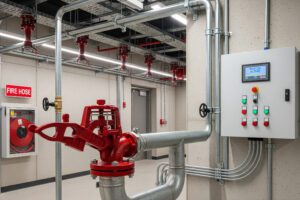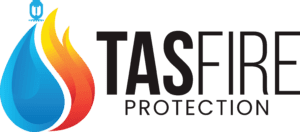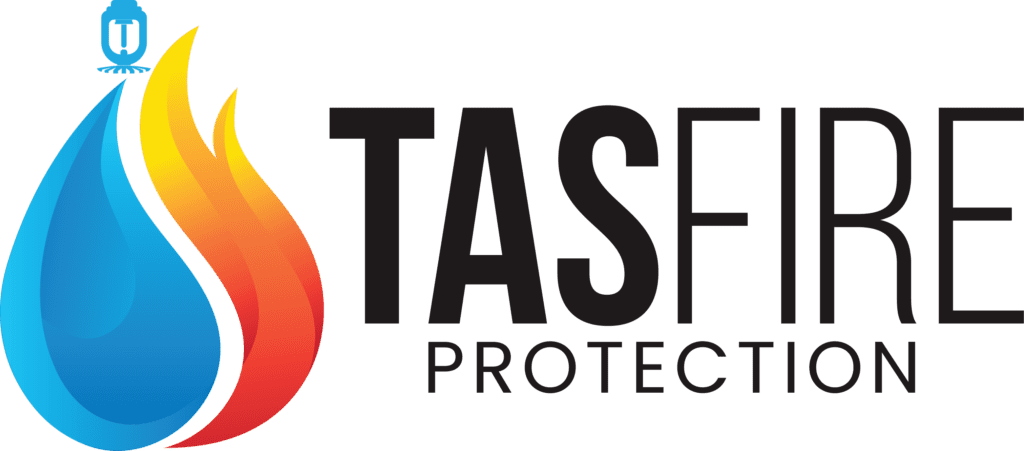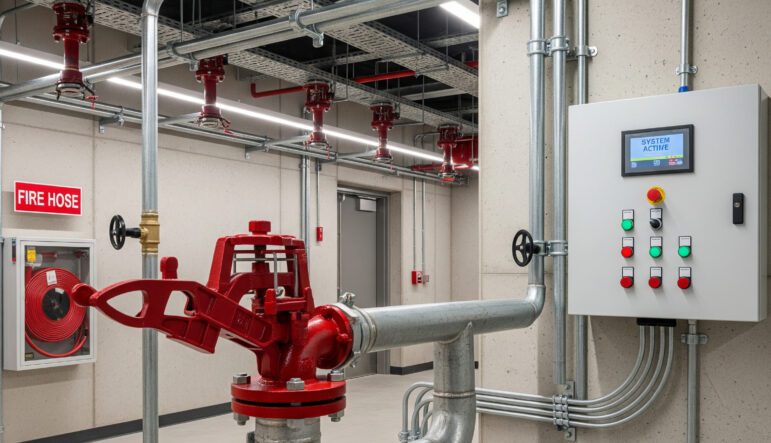Choosing the Right Fire Protection System for Your Business…
 Fire safety isn’t just about compliance – it’s about protecting your employees, customers, assets, and business continuity. With various fire protection systems available, selecting the right one can feel overwhelming. This guide will help you navigate the decision-making process and choose the ideal system for your unique business needs.
Fire safety isn’t just about compliance – it’s about protecting your employees, customers, assets, and business continuity. With various fire protection systems available, selecting the right one can feel overwhelming. This guide will help you navigate the decision-making process and choose the ideal system for your unique business needs.
Understanding the Importance of Fire Alarm Systems
Fire alarm systems serve as your first line of defense against fire hazards. They automatically notify emergency services, shut down HVAC systems to prevent smoke spread, and can activate suppression systems. These integrated responses can mean the difference between a minor incident and catastrophic loss.
Beyond safety, fire alarm systems are legally required in most commercial buildings. Failure to comply can result in hefty fines, forced closures, or worse – putting lives at risk. Additionally, properly functioning systems often reduce insurance premiums, as insurers view them as essential risk mitigation tools.
Knowing Your Business Needs
Every business faces unique fire risks based on its operations, layout, and occupancy. Understanding your specific needs is the foundation of selecting an effective system.
Consider Your Business Type:
- Retail spaces need systems protecting merchandise and ensuring customer evacuation
- Manufacturing facilities require specialized detection for industrial processes
- Offices focus on protecting people and electronic equipment
- Restaurants need kitchen-specific suppression alongside general fire detection
- Warehouses require wide-area coverage and early detection capabilities
Evaluate Your Physical Space: Size and layout directly impact system requirements. Large, open spaces may need fewer, more powerful detection devices, while multi-story buildings require complex zoned systems.
Assess Occupancy Levels: High-occupancy businesses need robust evacuation notification systems. Consider employees, customers, visitors, and varying occupancy throughout the day.
Types of Fire Alarm Systems to Consider
Conventional Fire Alarm Systems
Best For: Small to medium-sized businesses with simple layouts
Advantages: Cost-effective, simple installation, reliable performance
Disadvantages: Limited location specificity, challenging to pinpoint exact fire location
Addressable Fire Alarm Systems
Best For: Larger businesses, multi-story buildings, complex layouts
Advantages: Precise fire location identification, advanced diagnostics, flexible programming
Disadvantages: Higher upfront costs, more complex installation
Wireless Fire Alarm Systems
Best For: Historic buildings, retrofit installations, locations where wiring is impractical
Advantages: Minimal installation disruption, flexible placement, easy expansion Disadvantages: Higher equipment costs, battery maintenance requirements
Assessing Fire Risks in Your Business Environment
A thorough fire risk assessment is crucial for selecting appropriate protection. This involves identifying potential hazards, evaluating their likelihood and impact, and determining the best protection strategies.
Common Fire Hazards:
- Electrical systems (overloaded circuits, faulty wiring)
- Heating systems (furnaces, space heaters)
- Flammable materials (chemicals, fuels, paper products)
- Cooking equipment (commercial kitchens, break room appliances)
- Manufacturing processes (welding, cutting, high-heat operations)
- Storage areas (warehouses with combustible goods)
Risk Assessment Steps:
- Identify hazards throughout your facility
- Evaluate likelihood of each hazard causing a fire
- Assess potential consequences and impact
- Consider occupancy levels and evacuation needs
- Review historical data and industry incidents
Navigating Fire Safety Regulations and Compliance
Fire safety regulations vary by location, building type, and occupancy. Understanding applicable codes ensures your system meets legal requirements and provides adequate protection.
Key Standards:
- NFPA codes: Comprehensive standards for detection and suppression systems
- OSHA regulations: Workplace safety requirements
- Local building codes: Municipal requirements that may exceed national standards
- Industry-specific regulations: Special requirements for various sectors
Working with certified fire protection professionals ensures your system design meets all applicable codes and helps you avoid costly compliance issues.
Collaborating with Fire Safety Experts
Partnering with experienced fire safety professionals provides specialized knowledge, industry experience, and ongoing support for optimal system performance.
What Experts Provide:
- Comprehensive risk assessments
- Code compliance guidance
- Customized system design
- Installation oversight
- Staff training services
- Ongoing maintenance support
Request References and Reviews
Check References:
- Contact recent clients with similar businesses
- Ask about system performance, service quality, and responsiveness
- Verify projects were completed on time and within budget
Review Online Reputation:
- Check Google reviews, Better Business Bureau ratings
- Look for patterns in customer feedback
- Verify standing with professional associations
The Role of Technology in Modern Fire Alarm Systems
Today’s systems leverage advanced technology for faster, more accurate detection and improved integration with building management systems.
Smart Detection Technology:
- Multi-sensor detectors combining smoke, heat, and CO detection
- Aspirating smoke detectors for very early fire detection
- AI-powered analysis reducing false alarms
- Video fire detection using thermal imaging
Connectivity Features:
- IoT-enabled systems for remote monitoring
- Building automation integration
- Cloud-based monitoring services
- Real-time notifications to smartphones
Maintenance and Testing of Fire Alarm Systems
Regular maintenance ensures your system performs when needed and helps avoid compliance violations.
Required Activities:
- Monthly: Visual inspections, battery testing, alarm device verification
- Quarterly: Complete functional testing, device inspection
- Annual: Comprehensive performance testing, detector calibration, professional inspection
Professional Service: Most jurisdictions require annual inspections by certified technicians who perform detailed diagnostics, ensure code compliance, and provide official documentation.
Monitoring and Evaluating System Performance
Performance Indicators:
- System availability and uptime
- Response time for detection and reporting
- False alarm rate
- Maintenance costs and frequency
Schedule Consultations and Site Visits
Regular professional assessments ensure your system remains optimal:
- Review current performance and issues
- Assess business changes affecting fire protection needs
- Evaluate new technologies for improvements
- Plan for future expansion or renovations
Key Considerations and Decision Making
Budget Factors:
- Initial system cost and installation
- Ongoing maintenance expenses
- Insurance premium reductions
- Long-term return on investment
Technology Decisions:
- Current needs versus future-proofing
- Integration with existing systems
- Staff training requirements
- Scalability for business growth
Service and Support:
- Local service provider availability
- Emergency response times
- Quality of technical support
- Warranty coverage
Choosing the right fire protection system requires careful assessment of your specific risks, understanding available technologies, and collaboration with qualified professionals. The “best” system provides optimal protection for your needs while meeting regulatory requirements and fitting your budget.
Don’t wait to protect your business. Contact certified fire protection professionals for a comprehensive assessment and customized solution that provides optimal protection for your unique requirements.
FAQ
What is the most common fire protection device required in all businesses?
Smoke detectors are the most common requirement in virtually all commercial buildings, often combined with manual fire alarm pull stations near exits.
How do you choose a fire detection system?
Conduct a fire risk assessment, determine building requirements, research applicable codes, evaluate system types, consult with professionals, and compare quotes from qualified contractors.
What are the 12 ideal fire protection systems?
Key components include: fire detection systems, alarm systems, sprinkler systems, fire extinguishers, emergency lighting, exit signs, fire doors, voice evacuation, fire pumps, kitchen suppression, monitoring systems, and emergency response planning.
What is the best fire detection system?
Modern addressable systems with multi-sensor detectors often provide the best balance of accuracy, reliability, and functionality for most commercial applications, but the optimal choice depends on your specific needs and building characteristics.
We Provide Comprehensive Fire Protection Services
You understand the critical importance of fire protection services in safeguarding your property and, more importantly, your life and the lives of those around you. These services encompass a wide range of measures designed to prevent, detect, and suppress fires in your home or workplace.
> Learn More
Contact Us (905-870-7779) for a Free Consultation!
—

About TAS Fire Protection
TAS Fire Protection offers comprehensive and cutting-edge fire protection and security services to commercial, industrial, and high-rise properties. Our team of highly skilled professionals has years of experience in installing, maintaining, and inspecting fire alarm systems, fire sprinkler systems, fire extinguishers, fire hydrants, security alarm systems, and more. We understand that fire safety and security is essential to the protection of lives and property.
> Learn More

